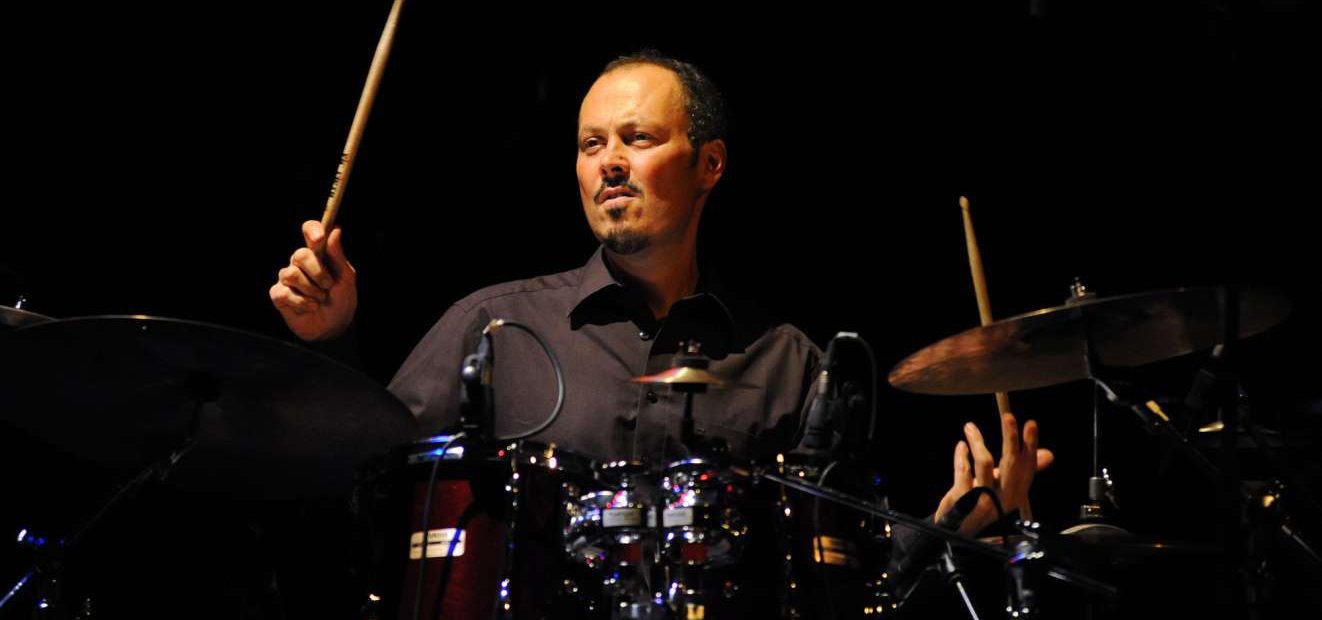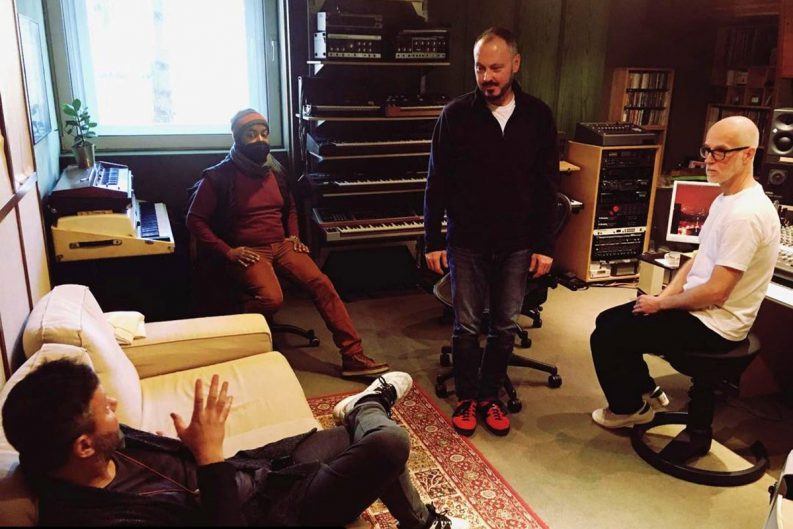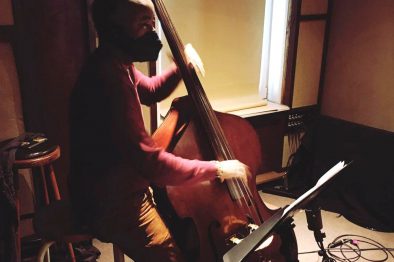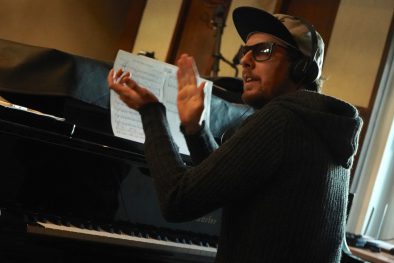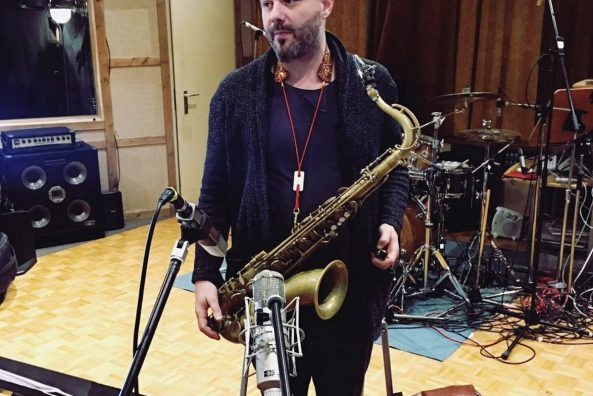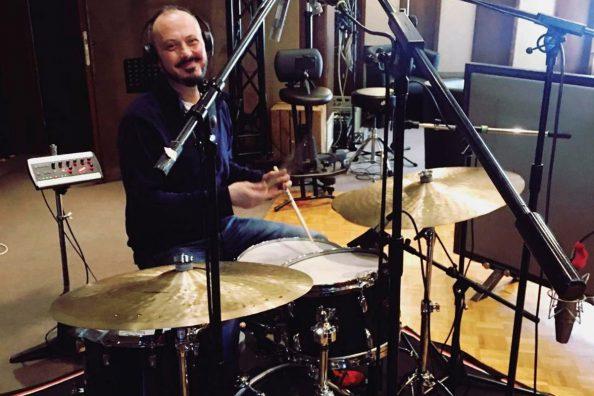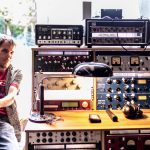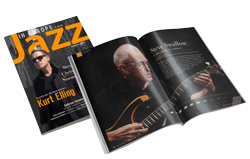On the 14th of October this year German based drummer Guido May released his first album as a leader titled “Flow”. For those unfamiliar with Guido, he is one of Germany’s top Jazz and Funk drummers with a list of credits that include the “creme de la creme” of the international jazz world. Perhaps best known for his long term collaboration with funk icon Pee Wee Ellis, Guido sees his latest album as a tribute to both Pee Wee and their 25 year long musical journey.
With this in mind, I thought it time to reach out to Guido to find out more about the album and what makes this drummer tick. I started by asking Guido how he first got into music and in particular jazz music, the first thing he did was blame his parents. “Seriously it was my parents fault, you know when you’re young you don’t know what you want. Anyway, not far from where I lived as a child, there was the Burghausen Jazz Festival and with my father being a jazz fan, he would go almost every year. I think it was around 1982 or 83 when he started to take me with him, I was only 12 or 13 at the time I think. I was amazed!
“Back then, the Burghausen jazz festival had some of the most famous musicians on the scene, on the program. The one concert that really made an impression on me was Art Blakey and seeing I always wanted to play drums, I wanted to be doing that. It was such an amazing band, Blakey was already quite old by that time but I still remember the power. You know that concert is actually on YouTube, maybe you can post the link.” (Ed, Consider it done – Here’s the link)
After leaving high school Guido did two years of social service. At that time in Germany you either had to do two years in the army or two years social service, naturally Guido choose for the latter. This took him to Munich where, at that time, the jazz scene was booming and it was in this period that Guido made his first steps in the industry as a professional drummer. “Munich was amazing in those day’s” explained Guido. He went on to explain, “There was not only a lot of clubs but a lot of touring musicians coming through, I remember seeing Pat Metheny, the Brecker Brothers, Weather Report and the list just goes on.
“I was spending a lot of time hanging out at sessions and eventually I started getting called for gigs. I think my first major gig was with Barbara Dennerlein, at the time she had a record deal with Verve Records and was doing really well. She had an international band with Denis Chambers on drums but she also had a European band and I played in that one. That was my way into the scene. I then had the opportunity to play with Klaus Doldinger (Ed, leader of the legendary German fusion band “Passport”), it was a crazy time, I remember one time playing in Munich in the afternoon with Barbera and then flying to Berlin for a gig with Klaus that night. So this was the beginning and I guess the rest was just by word of mouth.”
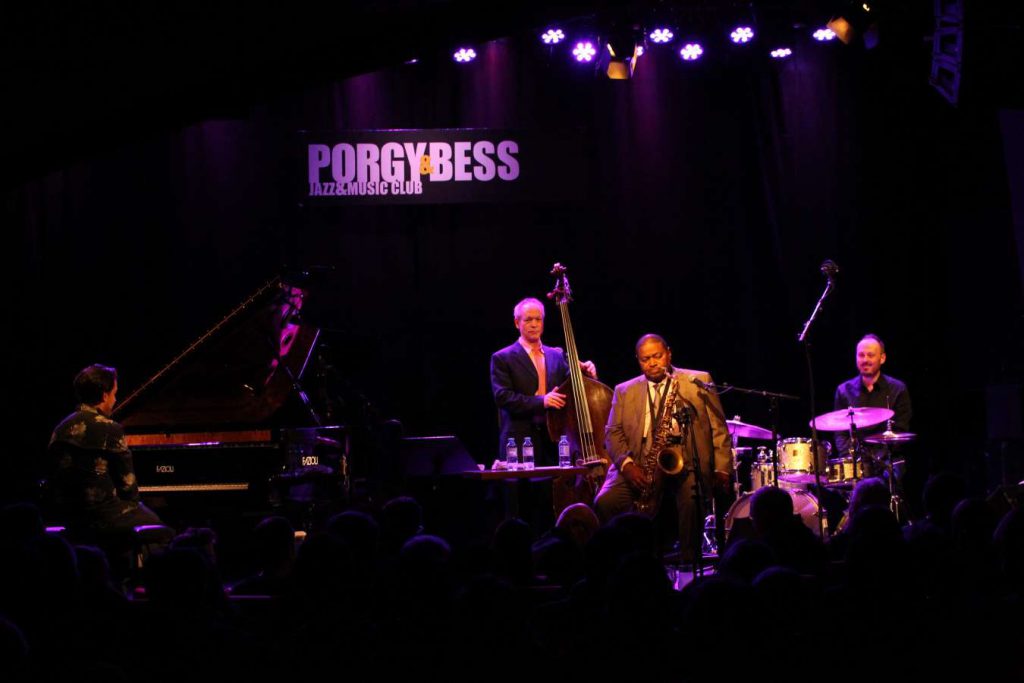
Guido May with Pee Wee Ellis at Porgy & Bess
Guido, is probably best known for his work with Pee Wee Ellis, He’s been a mainstay of Pee Wee’s band for close to 25 years. I was interested how this gig came about. Guido explained “Well, it’s sort of a long story but I’ll try and keep it short. Back in 1990, Maceo Parker did an album called Roots Revisited with Pee Wee and Fred Wesley on the Cologne based label Minor Records run by Stephan Meyner. After the success of that album, Stephan signed both Fred Wesley and Pee Wee but at the time Pee Wee didn’t have his own band. So Stephan asked Roberto Di Gioia, who was also playing with Klaus Doldinger at the time, to put a band together for Pee Wee’s album. Roberto was also living in Munich at the time and I had a band together with him and Patrick Scales (who was also the bassist in Doldinger’s band) so Roberto asked us to do the Pee Wee sessions. After that Pee Wee called me for a tour and that was it. 25 years later we’re still working together.”
As I mentioned above, Guido has just released his first album as a leader and while his new album Flow is technically his first release as a leader, he explained that there is another album that was recorded in 1997 and released under his name titled G-Strain. This album was more of a collaborative effort with Australian guitarist Peter O’Mara and trombonist Adrian Mears, Guido explains, “We had a band together called A-Strain and I had the opportunity to record so I asked them if we could put some material together in the form of a collaboration. I loved playing with those guys and seeing I don’t tend to write a lot of tunes, I asked them if they could come up with some material. You know, I’m not one of those guys that wake up in the morning and hears melodies or see colors, that’s just not me. I wish it was. I know a lot of people where this is the case, for example Adrian Mears, he’s been known to write ten song’s a day, amazing. But no that’s not really me. So anyway, the album was done and was released under my name with the title G-Strain, it was a play on words with the band A-Strain because the line up was effectively the same. But, the new album, “Flow” is totally different, that really is my project.”
Now, back to the here and now, some 25 years later, and Guido has just released his official debut album as a leader titled “Flow”. I wounded what it was that finally prompted Guido to record an album under his own leadership. He went on to say “Well to be honest, I was waiting for a trigger and I just didn’t have this until now. As you said before I’ve been very busy as a sideman for most of my career and I guess that’s pretty common for a drummer, but I think I’ve been very lucky in that respect. I’ve had the opportunity to play with many great players and when I look back at a list of people I’ve worked with, it actually is quite impressive. I didn’t even realize this until recently. But to get back to your question, up until now I’ve been very focused on working as a sideman but when the pandemic hit and there was nothing to do, I really stated to think that it’s time to record and album of my own.”
Over the years, Guido has worked with many top artists, not only in the jazz world but also in various other genres. I asked Guido if there were any memorable moments and he recalled a tour he did with Johnny Griffin and Kirk Lightsey. “I remember after the first gig, that we were sitting back stage and Johnny’s manager called. She did this all the time, you know Johnny was an acholic and towards the end had liver problems so she would always be calling to check things were OK. Anyway, I heard her say, ‘How was the new guy?’ Johnny said ‘Great, he was swinging’. At that time, I thought, few, but I thought it would be cool because during the gig, he came up to me on the drum riser and said, ‘He man, you sound great, I apologize that I’m in such bad shape.’ I couldn’t believe it.”
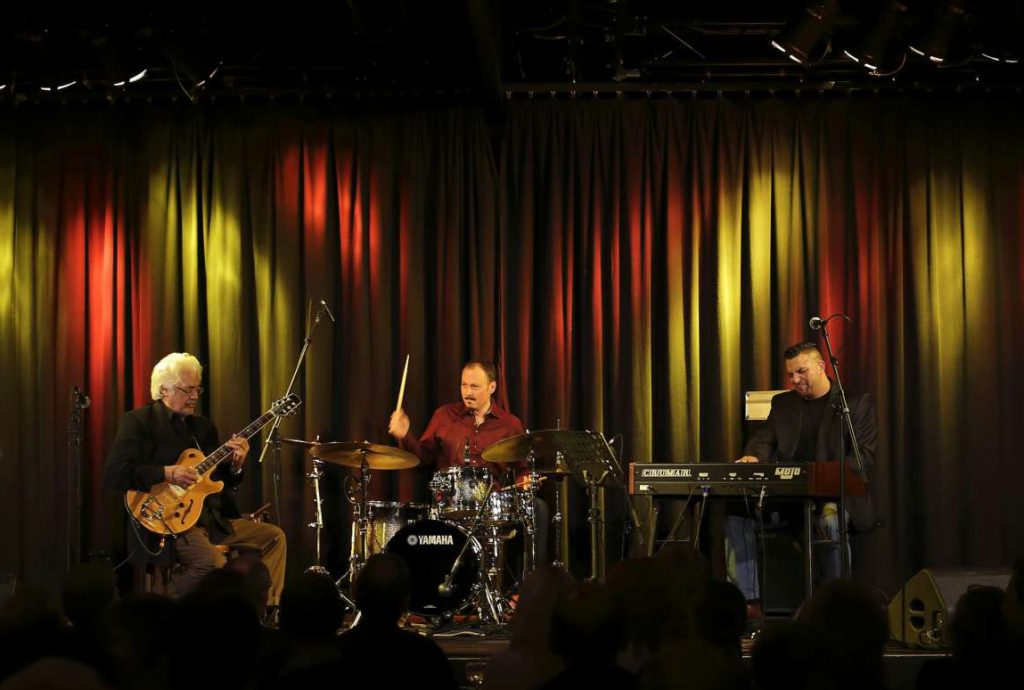
Guido May with Larry Coryell | Photo © On Stage Photos
This was just on anecdote that Guido told shared with me, there were many other stories about, Benny Golson, Lionel Hampton, Larry Coryell and many more, however, moving back to speak about the new album, Guido explained that all of his years of work playing with these legends in the jazz world had a profound influence on him and it is these influences that he wanted to form the basis for the “Flow” Album. Guido expanded on this by saying “Through the years I learned that it’s all about going with the flow, I like to sit on a feel and expand on it for an extended periods, it doesn’t matter what the feel is, it’s all about what you do with it. So, this is where the title comes from but it’s more than that, it’s all about sitting in the groove and doing something with it that adds to it.”
Having heard the album, when you listen to it in this context you can hear what Guido’s talking about. It’s not an album full of clever drum solo’s, in fact I think there’s only one drum solo on the entire recording, it’s an ensemble album but with every track, the groove is king. I wanted to know how Guido went about choosing the line-up for the album. He explained “It was back in 2020 that I took part in a series of auditions for the professorship at the university of Graz in Austria. They were looking for a drum professor for the jazz faculty and held auditions for a week. Seriously, the candidates came from all over the globe and when I got the list of who was taking part, I thought I’ve got no chance.
Anyway, to make a long story short, as part of the audition you had to present a concert, not only for the jury but they were open auditions and the whole faculty were there, No Stress! So, in the band that I had available was Jure Pukl (Tenor saxophone) and Marko Chunchetz (piano) and I had one hour to rehearse the band. After about 20 minutes I realized we didn’t really need to rehearse, they just got it straight away, so we just picked some tunes and that was it. Anyway during the concert we played a ballad and it was just so beautiful. Jure’s tenor tone touched me so much that I actually started to cry on the inside, it was like a spirituel experience and at that time I knew no matter what happens, now it’s time to record an album and I have to have both Jure and Marko on play on it.
I reminded Guido that this is only two thirds of a quartet and wanted to know about the bass chair. He explained “I really wanted Ameen Saleem to play bass. We did a tour in Europe with Italian piano player Antonio Faraò together and when we played it just clicked. I still remember that after the first rehearsal we compared out playlists and they were almost exactly the same. There was an immediate click between the two of us so when I started to think about who I wanted to play bass on the album, he was my first choice and luckily he was available.” After all this, I was interested to know if Guido got the gig at Graz, the answer was a short “no”.
I love interviews where I don’t really need to ask many questions, and this interview was one of these cases. Guido, reminds me of the Energizer Bunny, once switched on, he runs forever. So, just after we finished about talking about the line-up Guido launched straight in to how the recording took place. Back to Guido, “I had booked the hotel, taken care of the catering and all the other details so when it came time to record, we first agreed to meet in the hotel to run through the music. So I turned up, ordered some drinks and handed out the charts. We ran through them, discussed a few ideas and that was the rehearsal.
“The next day we arrived at the studio and, I’m not kidding, 8 hours later we had recorded the whole album. It was an amazing experience. When I listened back, I couldn’t believe it, it sounded exactly how I had envisioned it. Then, to top things off, the next day we mixed the album in two hours.”
Moving on I wanted to know if Guido had plan’s to tour with the band on the album, “Yes, for sure. luckily I have a good network so booking gigs has not been all that difficult and next September we’ll be on the road, I think at the moment there are 5 gig’s locked in but there will be more, I just have to lock them in.
To finish up, I asked Guido a question that I tend to always include in an interview and that’s “what do you have on your bucket list”. I have received many answers to this question over the years and usually the interviewee lists a number of the musical goals they want to achieve however Guido’s answer was something different. Guido told me that in June of this year he suffered a heart attack that came close to taking his life. Luckily he survived without to much permanent damage but this experience has changed his outlook on life. He explained “well if you had of asked me this question six months ago I would have said, Oh, I want to play with this band or recorded this music, or get this technique down etc, but now my plan is just to enjoy every day to the best I can. This is what makes life worth living and this is something I didn’t get before. Maybe this incident was necessary to make me realize what’s important in life.
If you want to hear more from Guido, you can check out his album here, or visit his website.
Last modified: December 14, 2022


